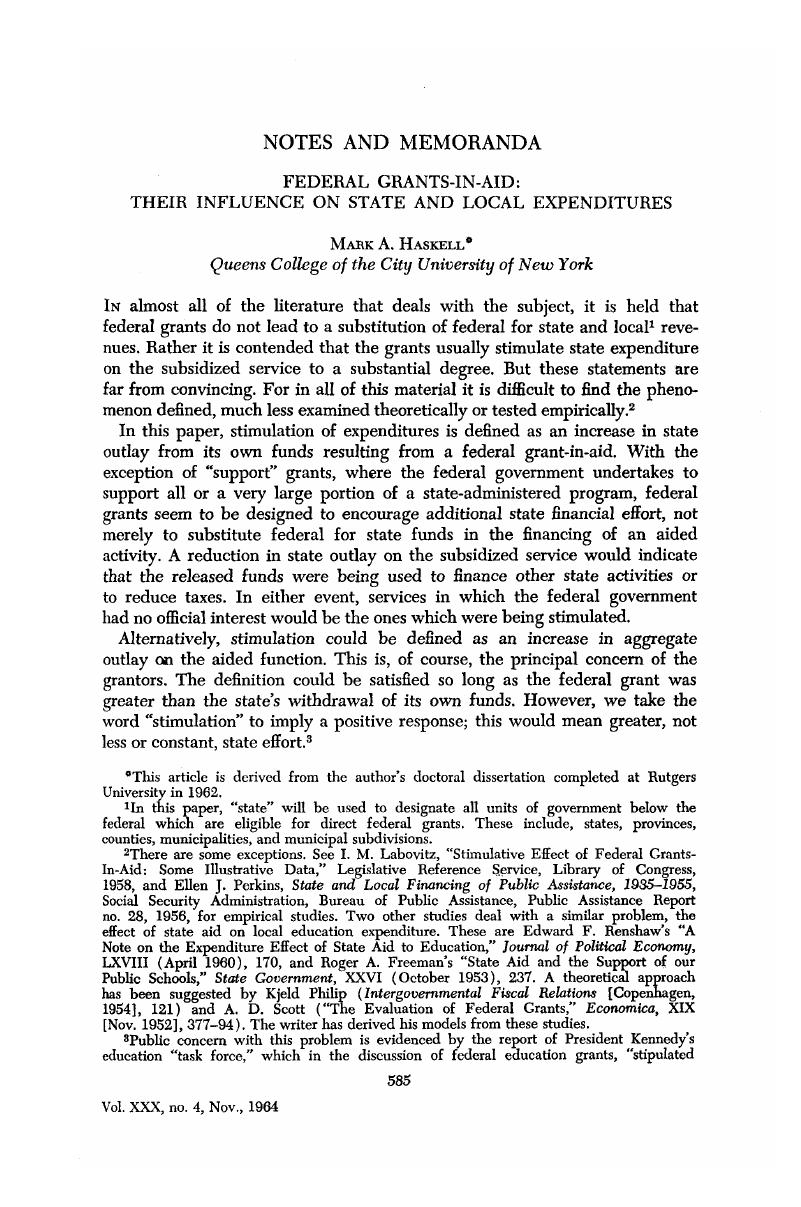Published online by Cambridge University Press: 07 November 2014

1 In this paper, “state” will be used to designate all units of government below the federal which are eligible for direct federal grants. These include, states, provinces, counties, municipalities, and municipal subdivisions.
2 There are some exceptions. See Labovitz, I. M., “Stimulative Effect of Federal Grants-In-Aid: Some Illustrative Data,” Legislative Reference Service, Library of Congress, 1958 Google Scholar, and Perkins, Ellen J., State and Local Financing of Public Assistance, 1935–1955, Social Security Administration, Bureau of Public Assistance, Public Assistance Report no. 28, 1956 Google Scholar, for empirical studies. Two other studies deal with a similar problem, the effect of state aid on local education expenditure. These are Renshaw's, Edward F. “A Note on the Expenditure Effect of State Aid to Education,” Journal of Political Economy, LXVIII (04 1960), 170 CrossRefGoogle Scholar, and Freeman's, Roger A. “State Aid and the Support of our Public Schools,” State Government, XXVI (10 1953), 237.Google Scholar A theoretical approach has been suggested by Philip, Kjeld (Intergovernmental Fiscal Relations [Copenhagen, 1954], 121)Google Scholar and Scott, A. D. (“The Evaluation of Federal Grants,” Economica, XIX [11 1952], 377–94).CrossRefGoogle Scholar The writer has derived his models from these studies.
3 Public concern with this problem is evidenced by the report of President Kennedy's education “task force,” which in the discussion of federal education grants, “stipulated that the states should be required to maintain or increase their present support of education, not use the Federal aid to reduce their own share of school expenditures.” New York Times, 01 7, 1961, 1.Google Scholar
4 Leftwich, Richard A., The Price System and Resource Allocation (New York, 1955), 43.Google Scholar
5 See Fabricant, Solomon, The Trend of Government Activity in the United States since 1900 (New York, 1952).Google Scholar In regard to the individual consumer, Stigler, George (The Theory of Price, rev. ed. [New York, 1952], 45)Google Scholar suggests that just as “Income elasticities often rise with income … price elasticities may also rise with income.” An exception may be services such as welfare, the need for which varies inversely with per capita income. But short of the extreme case where there are few or no needy citizens in a state, even this expenditure can adhere to the general rule. High-income states may choose to treat their needy so generously that both per capita expenditures on welfare and welfare expenditures relative to income are higher than in low-income states. Many examples of this can be found.
6 For an interesting discussion of the effect of theories of “social relations” on government expenditures, see Adams, Henry C., The Science of Finance (New York, 1898), 46–9.Google Scholar Adams refers to ideas concerning the “respective rights and duties of government and individuals” and the resulting nature of collective activity, i.e., whether it tends to be voluntary or coercive. He contrasts the English tradition with the Continental, the former placing the individual in major focus, the latter viewing the state as an organism. Where the English tradition is dominant, greater reliance is placed upon voluntary association in providing for collective needs. Consequently, aggregate government expenditure, ceteris paribus, is likely to be less than in an environment where government activity is viewed more favourably.